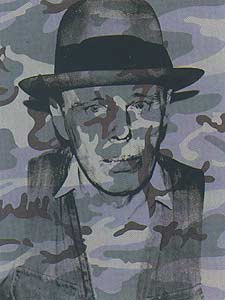EDITION:
Edition of 90, 20 AP, 5 PP, 5 HC, 30 numbered in Roman numerals, signed and numbered in pencil lower left. There are 26 TP signed in pencil and unnumbered; some are on Arches 88 paper, 41" x 29.5".
|
Joseph Bueys: He was an influential German artist who came to prominence in the 1960s. He is most famous for his ritualistic public performances and his energetic championing of the healing potential of art and the power of a universal human creativity. As well as performances, Beuys produced sculptures, environments, vitrines, 450 prints and posters, and thousands of drawings. He was also a committed teacher and increasingly devoted much of his energy to German politics. A charismatic and controversial figure, the nature and value of Beuys’s contribution to Western art has elicited a hotly contested and often polarised debate. Beuys’s first solo exhibition in a private gallery was opened on November 26, 1965 with one of the artist’s most famous and compelling performances: How to Explain Pictures to a Dead Hare. The artist could be viewed through the glass of the gallery’s window. His face was covered in honey and gold leaf, an iron slab was attached to his boot. In his arms he cradled a dead hare, into whose ear he mumbled muffled noises as well as explanations of the drawings that lined the walls. Such materials and actions had specific symbolic value for Beuys. For example, honey was the product of bees who, for Beuys (following Rudolf Steiner), represented as ideal society of warmth and brotherhood. Gold had its importance within alchemical enquiry, and iron, the metal of Mars, stood for a masculine principle of strength and connection to the earth. Beuys produced many such spectacular, ritualistic performances, and he developed a compelling persona whereby he took on a liminal, shamanistic role, as if to enable passage between different physical and spiritual states. Further examples of such performances include: EURASIA (1965), Celtic (Kinloch Rannoch) Scottish Symphony (1970), and I Like America and America Likes Me (1974). (http://en.wikipedia.org/wiki/Joseph_Beuys).
|
|
ADDITIONAL INFORMATION
Published in the portfolio for Joseph Beuys, containing works by thirty artists, as a hommage to Joseph Beuys after his death in 1986.
Printer: Rupert Jasen Smith, New York
Publisher: Galerie Bernd Klüser, Munich, Germany; Edition Schellmann, Munich, Germany/New York |
|
